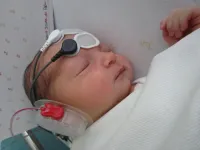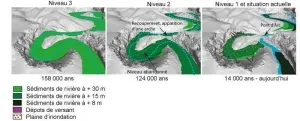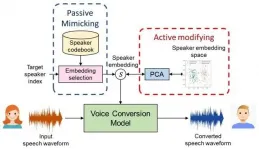(Press-News.org) People's ability to perceive speech sounds has been deeply studied, specially during someone's first year of life, but what happens during the first hours after birth? Are babies born with innate abilities to perceive speech sounds, or do neural encoding processes need to age for some time?
Researchers from the Institute of Neurosciences of the University of Barcelona (UBNeuro) and the Sant Joan de Déu Research Institute (IRSJD) have created a new methodology to try to answer this basic question on human development.
The results, published in the Nature's open-access journal Scientific Reports, confirm that newborn neural encoding of voice pitch is comparable to the adults' sabilities after three years of being exposed to language. However, there are differences regarding the perception of spectral and temporal fine structures of sounds, which consists on the ability to distinguish between vocal sounds such as /o/ and /a/. Therefore, according to the authors, neural encoding of this sound aspect, recorded for the first time in this study, is not found mature enough after being born, but it needs a certain exposure to the language as well as stimulation and time to develop.
According to the researchers, knowing the level of development typical in these neural encoding processes from birth will enable them to make an "early detection of language impairments, which would provide an early intervention or stimulus to reduce future negative consequences".
The study is led by Carles Escera, professor of Cognitive Neuroscience at the Department of Clinical Psychology and Psychobiology of the UB, and has been carried out at the IRSJD, in collaboration with Maria Dolores Gómez Roig, head of the Department of Obstetrics and Gynecology of Hospital Sant Joan de Déu. The study is also signed by the experts Sonia Arenillas Alcón, first author of the article, Jordi Costa Faidella and Teresa Ribas Prats, all members of the Cognitive Neuroscience Research Group (Brainlab) of the UB.
Decoding the spectral and temporal fine structure of sound
In order to distinguish the neural response to speech stimuli in newborns, one of the main challenges was to record, using the baby's electroencephalogram, a specific brain response: the frequency-following response (FFR). The FFR provides information on the neural encoding of two specific features of sound: fundamental frequency, responsible for the perception of voice pitch (high or low), and the spectral and temporal fine structure. The precise encoding of both features is, according to the study, "fundamental for the proper perception of speech, a requirement in future language acquisition".
To date, the available tools to study this neural encoding enabled researchers to determine whether the newborn's baby was able to encode inflections in the voice pitch, but it did not when it came to the spectral and temporal fine structure. "Inflections in voice pitch contour are very important, especially in tonal variations like in Mandarin, as well as to perceive the prosody from speech that transmits emotional content of what is said. However, the spectral and temporal fine structure of sound is the most relevant aspect in language acquisition regarding non-tonal languages like ours, and the few existing studies on the issue do not inform about the precision with which a newborn's brain encodes it", note the authors.
The main cause of this lack of studies is the technical limitation caused by the type of sounds used to conduct these tests. Therefore, authors have developed a new stimulus (/oa/) whose internal structure (increasing change in voice pitch, two different vocals) allows them to evaluate the precision of the neural encoding of both features of the sound simultaneously using the FFR analysis.
An adapted test to the limitations of the hospital environment
One of the most highlighted aspects of the study is that the stimulus and the methodology are compatible to the typical limitations of the hospital environment in which the tests are carried out. "Time is essential in the FFR research with newborns. On the one hand, because recording time limitations determine the stimuli they can record. On the other hand, for the actual conditions of the situation of newborns in hospitals, where there is a frequent and continuous access to the baby and the mother so they receive the required care and undergo evaluations and routine tests to rule out health problems", authors add. Considering these restrictions, the responses of the 34 newborns that were part of the study were recorded in sessions that lasted between twenty and thirty minutes, almost half the time used in common sessions in studies on speech sound discrimination.
A potential biomarker of learning problems
After this study, the objective of the researchers is to characterize the development f neural encoding of the spectral and temporal fine structure of speech sounds over time. To do so, they are currently recording the frequency-following response in those babies that took part in the present study, who are now 21 months old. "Given that the two first years of life are a critical period of stimulation for language acquisition, this longitudinal evaluation of the development will enable us to have a global view on how these encoding skills mature over the first months of life", note the researchers.
The aim is to confirm whether the observed alterations -after birth- in neural encoding of sounds are confirmed with the appearance of observable deficits in infant language development. If that happens, "that neural response could be certainly considered a useful biomarker in early detection of future literacy difficulties, just like detected alterations in newborns could predict the appearance of delays in language development. This is the objective of the ONA project, funded by the Spanish Ministry of Science and Innovation", they conclude.
INFORMATION:
Not all stars shine brightly all the time. Some have a brightness that changes rhythmically due to cyclical phenomena like passing planets or the tug of other stars. Others show a slow change in this periodicity over time that can be difficult to discern or capture mathematically. KAUST's Soumya Das and Marc Genton have now developed a method to bring this evolving periodicity within the framework of mathematically "cyclostationary" processes.
"It can be difficult to explain the variations of the brightness of variable stars unless they follow a regular pattern over time," says Das. "In this study we created methods that can explain the evolution of the brightness of a variable star, even if it ...
Per- and polyfluoroalkyl substances (PFAS) in ski wax have been receiving a lot of attention recently, but waxes constitute only a limited part of the problem of the PFAS group of toxicants.
PFAS are a large group of man-made fluorocarbon toxicants, and you are most likely full of them. The toxic substances don't break down and instead accumulate, both in nature and in your body.
"Due to their extensive use, humans and animals all over the world are continuously exposed to PFAS," says Håkon Austad Langberg, a PhD candidate at the Norwegian University of Science and Technology (NTNU) who has studied several of them in the last few years.
PFAS are used in many different products beyond the fluorinated ski wax that ends up in the ground on ski slopes and on trails, ...
The corona pandemic has made us all focus on new ways of organizing our work. More and more companies and organizations around the world are considering how to meet their employees' demand for flexibility while at the same time reducing their office space and expensive rents.
There are advantages and disadvantages to working from home, and many factors that affect the peoples' experience of it, such as their job function, age and seniority, whether they have children, whether they are a manager or employee, etc.
Researchers from DTU Management have identified six main areas that company managers should focus on when developing strategies for remote work in future.
Associate Professor at DTU Management Christine ...
People who take a commonly-prescribed drug for inflammatory bowel disease (IBD) should not assume they are protected after a first dose of COVID-19 vaccine, after a large-scale study found many had poor antibody responses.
The research measured antibody responses after vaccination with the Pfizer/BioNTech or the Oxford/AstraZeneca COVID-19 vaccine in 865 people treated with infliximab, an anti-tumour necrosis factor (anti-TNF) biologic drug, prescribed to around two million people worldwide. Anti-TNF drugs are effective treatments for immune-mediated inflammatory ...
The Chauvet Cave, which lies by the entrance to the Gorges of the Ardèche, is home to the world's oldest cave paintings, dating back 36,000 years. Their state of preservation and aesthetic qualities earned them a spot on the World Heritage List in 2014, 20 years after their discovery. The location of the cavern--surrounded by a remarkable landscape, next to the Pont d'Arc natural archway--raises the question of whether the people who executed these artworks looked and walked out upon the same landscape as today. Did they see the same natural archway? Scientists from the CNRS, Université Savoie Mont Blanc, and the Muséum National d'Histoire Naturelle1 ...
Researchers from Skoltech (Russia) and their colleagues from SINTEF (Norway) have developed a mathematical model of freezing water droplets moving in cold air. This model is a part of a joint RFBR-supported Russian-Norway research project. The project is focused on predicting ice accretion on ships and other offshore structures operated in Arctic climate, which may interfere with their proper functioning and endanger crew members and cargo. The paper was published in the journal Energies.
Ships travel in cold northern waters under constant bombardment by tiny water droplets populating the chilly air. ...
Ishikawa, Japan - Robots today have come a long way from their early inception as insentient beings meant primarily for mechanical assistance to humans. Today, they can assist us intellectually and even emotionally, getting ever better at mimicking conscious humans. An integral part of this ability is the use of speech to communicate with the user (smart assistants such as Google Home and Amazon Echo are notable examples). Despite these remarkable developments, they still do not sound very "human".
This is where voice conversion (VC) comes in. A technology used to ...
Just one third of people in the UK managed to access the hospital care they needed at the peak of the first wave of the Covid-19 pandemic - according to new research from the University of East Anglia.
A new study published today looks at the extent to which people managed to access NHS healthcare in April 2020, and as lockdown restrictions eased.
The researchers found that, despite high levels of unmet need, there was equal access to NHS hospital care for people at different levels of income. And the NHS principle of equal treatment for equal need was upheld.
However, people on higher incomes had better access to GP consultations, prescriptions and medical helplines at ...
Steroids should not be used to treat smell loss caused by Covid-19 according to an international group of smell experts, including Prof Carl Philpott from the University of East Anglia.
Smell loss is a prominent symptom of Covid-19, and the pandemic is leaving many people with long-term smell loss.
But a new study published today shows that corticosteroids - a class of drug that lowers inflammation in the body - are not recommended to treat smell loss due to Covid-19.
Instead, the team recommend 'smell training' - a process that involves sniffing at least four different odours twice a day for several months.
Smell loss expert Prof Carl Philpott from UEA's Norwich Medical School, said: "The huge rise in smell loss caused by Covid-19 has created an unprecedented worldwide demand for ...
According to the Motorik-Modul-Längsschnittstudie (MoMo, Motor Module Longitudinal Study) of Karlsruhe Institute of Technology (KIT) and Karlsruhe University of Education (PHKA), mental health of children and adolescents decreased during the first lockdown. For children aged between 4 and 10 years and for girls irrespective of their age, mental health was found to promote physical activity during Covid-induced lockdown in spring 2020. This is reported in Children (DOI: 10.3390/children8020098).
"The impacts of the lockdown on children and adolescents is discussed widely," ...




